Potato (Solanum tuberosum) is the world’s fourth most important food crop and the largest vegetable crop in the United States. The Potato (Solanum tuberosum) is a nightshade family member, including Tomatoes, Peppers, and Eggplants. Unlike most specialty crops, Potatoes are grown commercially primarily on multi-breed family-owned farms, supporting countless communities in almost every state in the USA. Potato farming in the USA is the most profitable business. Let’s check out more information on how to start potato farming in USA below.
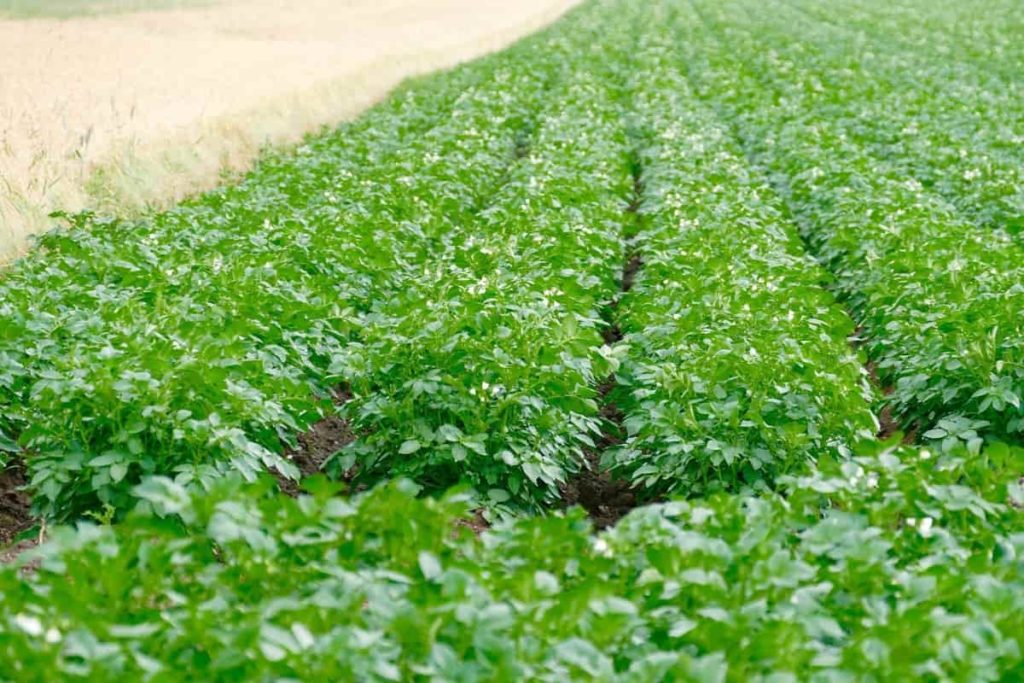
How to start Potato farming in USA
Potato-producing states in the USA
Potato is the leading crop in the USA. They are grown commercially in approximately 30 states, but Idaho grows more potatoes than any other state, followed by Washington. North Dakota, Wisconsin, and Colorado are also top producers of Potatoes. The yield of a Potato crop is determined by many factors such as crop breed, seed age and quality, crop management methods, and plant environment.
Improving one or more of these yield determinants and closing the yield gap could significantly boost food security and farmers’ incomes in the developing world. In the USA, Idaho is the largest Potato-producing state. The second, third, fourth, and fifth largest Potato growers in the United States are Washington, Wisconsin, Oregon, and North Dakota.
Idaho
Idaho produces 134,850 thousand centum weight (cwt) of Potatoes each year. The state’s favorable climate, volcanic soil, and irrigation programs can be attributed to higher production. Potatoes are known as the Idaho State vegetable because of their popularity.
Washington
The annual production of Potatoes in Washington is 99,220 thousand cwt. Eighty-seven percent of these Potatoes are sold to processors for about ً 4.6 billion. The Potato industry in Washington employs 23,500 people. Most Potatoes are grown in Grant County, which harvests in July.
In case you missed it: Fertilizer Management in Potatoes: Organic, Compost Manure, NPK, and Schedule
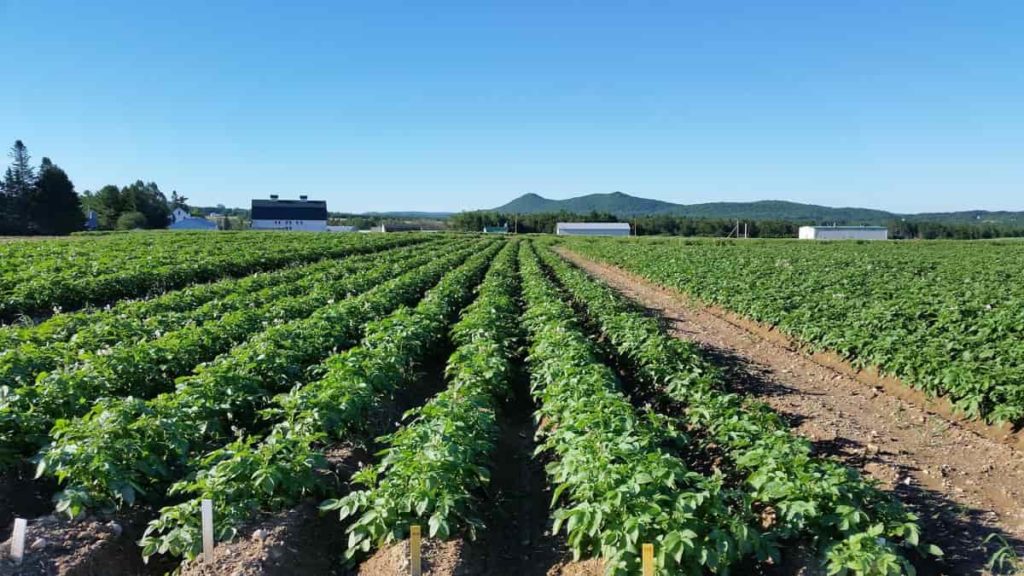
Wisconsin
The state is popular for its Potato production as it ranks third among the US states.
Oregon
Oregon is one of the places with the highest Potato production per acre. About 15% of Oregon-grown Potatoes are exported to foreign markets.
Site selection for Potato farming in the USA
Potatoes need full sun for the best yield. They work best in loose, well-drained, slightly acidic soils. Poor drainage soils often lead to poor standing and low productivity. Heavy soils can make tubers small and rough.
Different Potato varieties in the USA
Approximately more than 200 varieties of Potatoes are sold throughout the United States. Each of these Potatoes fits into one of seven types: Blue/Purple, Russet, Red, White, Yellow, and Petite. Potato varieties grown in the United States;
- Russet Burbank
- Russet Norkotah
- Ranger Russet
- Umatilla Russet
- Frito-Lay varieties
- Norland
Choose the type of Potato that best suits your situation and market. It’s also a good idea to try new types of on-farm trials. Successful categories can then be introduced to users for input to make decisions for future categories. Buyers of Potato contracts will determine the varieties to be grown.
The main varieties of Potatoes grown in the United States are;
Russet Potatoes – Russet is the most widely used variety of Potatoes in the United States. These Potatoes are available all year round, are high in starch, and have brown skin and white flesh. Due to their high starch level, when cooked, they have the texture of flour, which makes them ideal for baking and meshing. They are also thought to be good Potatoes for all purposes. The main types include Burbank, Norkotah, Ranger, and Shepody.
Round white Potatoes – These are available all year round. The round whites are medium in starch and have smooth, thin, light tan skin with white flesh. They are creamy in texture and keep their shape well after cooking. Known as an all-purpose Potato, round whites are versatile and especially good for salads and scalloped, steamed, or fried preparations. The main varieties include Atlantic, Katahdin, Norwis, Reba, and Superior.
Long white Potatoes – When cooked, their texture is strong and creamy. They are available almost all year round. These Potatoes are good for boiling, microwaving, and pan-frying; they are also good all-purpose Potatoes. The main types include Burbank, Norkotah, Ranger, and Shepody.
Yukon Gold Potatoes – Yukon Gold Potato is one of the most popular Potato varieties as it falls into the all-purpose category. Yukon Golds have a thin golden skin that does not need to be peeled before mashing, and their creamy flesh has a sweet flavor.
In case you missed it: Top 20 Steps to Boost Potato Yield: How to Increase Production, Size, and Quality
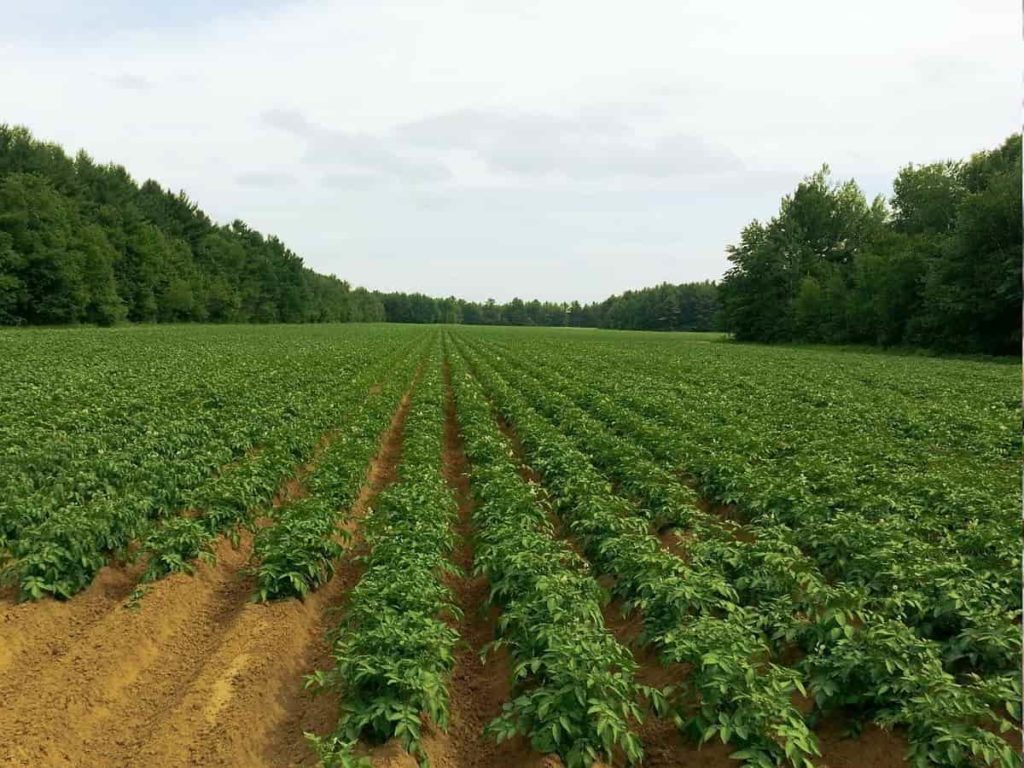
Adirondack Blue Potato – Adirondack Blue Potato is a purple variety with brightly colored skin and flesh that retains its ultraviolet color after cooking. Other varieties lose some of their luster and turn gray when cooked, making Adirondack Blue the best choice when you want to show off your vibrant color.
Red Potatoes – The more widely available round reeds can now be found almost all year round. They are naturally pinkish-red skin but may have white, yellow, or even red flesh. The texture of red Potatoes is strong, smooth, and waxy, making them suitable for salads, roasting, boiling, and boiling. Round reds are often called “new Potatoes.” The main types include Chieftain, Dakota Rose, La Rouge, Norland, and Red La Soda.
Yellow Potatoes – Yellow Potatoes are more popular in the USA. These Potatoes have a dense, creamy texture, golden color, and light butter flavor; this type of Potato is mixed, roasted, baked, boiled, and steamed. Key varieties include Yukon Gold, German Butterball, and Sierra Gold.
Purple and Blue Potatoes – They have begun to gain popularity in the United States. Blue and purple Potatoes are available in the fall season. Key varieties include Purple Peruvian and All Blue.
When to plant Potatoes
Planting time is significant in Potatoes. For many gardeners, this is about two weeks after the last frost of spring. But be aware that wet soil can destroy early crops because Potato seeds will rot. Focus on the soil over the calendar to determine when to plant. The growing soil should not be so wet that it sticks together and is difficult to work with.
Firstly, let it dry a bit. For the late and wet spring season, you can plant later – April (depending on location) or June, especially in containers. The United States Potato-growing areas boast rich, fertile soil and a climate suited for Potato budding. These factors mean that American Potato growers can at least use pesticides and fertilizers, making them more sustainable farming methods.
Growing Potatoes in Florida
Growing Potatoes in Florida produces a variety of commercial varieties of Potatoes grown in other parts of the country. Most American farmers grow russet Potatoes. The late ripening of russet Potatoes makes them more susceptible to diseases, pests, and bad weather. The popularity and success of Potato varieties in Florida depend on factors such as yield, disease resistance, quality, and adaptation.
Requirements for Potato production in the USA
Potatoes are a cold-season crop and are grown in the spring months and harvested in early summer in Oklahoma. Potato production in the fall is usually the result of plant weakness and low yields due to high soil temperatures at the planting time and early crop development. Potatoes grow best in fertile, well-drained soils. Planting on poorly drained lands usually results in poor plant quality due to the rot of seed fragments and poor-quality Potatoes at harvest time.
In case you missed it: Growing Organic Sweet Potatoes – Planting, Farming, Tips, Ideas
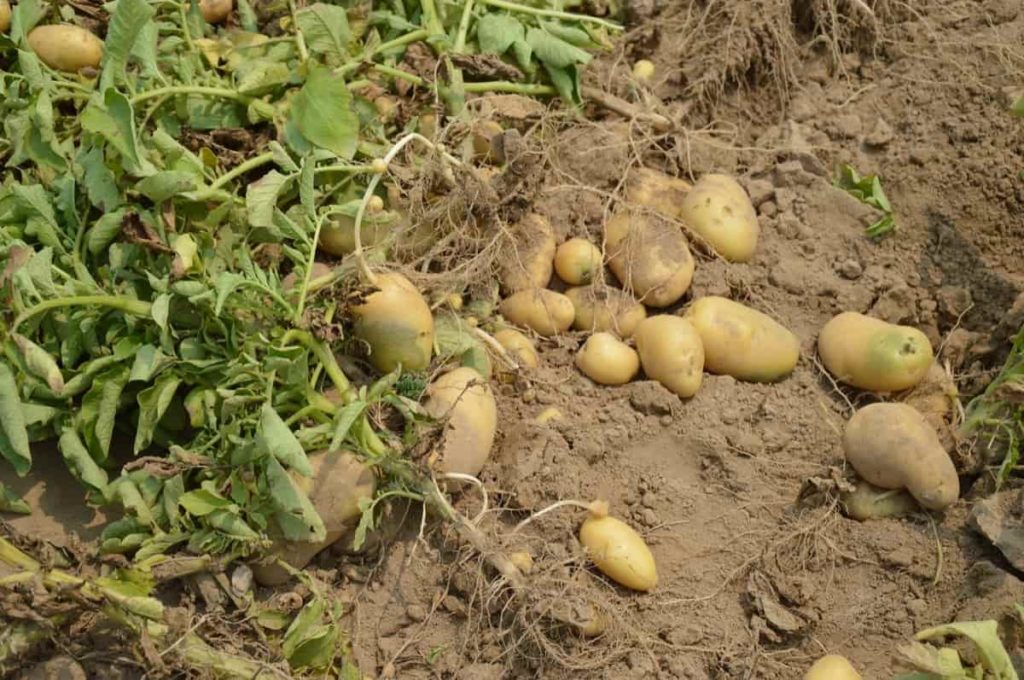
Soils that are sensitive to wind erosion or have a low water holding capacity should be avoided. Oklahoma has a good Potato yield of 200 to 250 pounds per acre. High temperatures or insufficient humidity in late spring and early summer reduce the yield when the Potatoes become blunt. With better management and climatic conditions, it is possible to produce 300 kg of weight per acre.
Farmers in the United States take good care of the soil. They rotate their Potato crop, i.e., Potatoes are planted on the same land only once every 3-5 years. Farmers work with certified agronomists to monitor soil nutrient levels. The Global Positioning System (GPS) enables farmers to target the right fertilizer needed to avoid applying too much or too little. As the Potatoes grow in the ground, growers and agronomists monitor their growth, checking their moisture levels, solids, and sugar content.
Planting process in Potato farming in the USA
Use only certified seed tubers. Potato production costs are so high that there is no risk of using uncertified seeds. Good quality certified seeds grown in North America generally produce the highest yields, quality tubers, and the least disease problems. Used for planting pieces of large seed tubers. The use of small seed pieces usually leads to lower yields.
Cuttings of sown seeds can be pruned before planting, but planting freshly sown seeds is a common practice, as growers usually have the time and space to store large quantities of sown seeds before planting. Treating seed fragments with fungicides may not always be necessary, as research shows that such use is likely to increase yields only if planted with cut seed fragments. Store three or more days in advance.
The seed required to plant an acre depends on the size of the seed pieces and the seed spacing. The distance between the rows is usually 36 inches. Planting should begin in early March in central Oklahoma and mid-March in North Oklahoma to promote early crop growth and avoid extreme heat temperatures.
Many planters are available that put seed fragments into the soil and apply fertilizers and systemic pesticides in one operation. The depth of the seed must be about 4 inches below the top of the planted bed. During the initial planting, the soil is added to the plants in rows, so when the tuber is formed, about 6 inches of soil covers the seed piece. The depth of the hill varies in different types.
Nutrients for Potato Growth
The nutrition of each plant has its role in Potato cultivation:
- Nitrogen – is important in accelerating growth and providing high yields; it ensures maximum photosynthetic production in the leaves.
- Phosphate – Foliar phosphate, applied just before the start of the tuber, increases the total number of tubers while applying after the tuber starts the size of the tuber, thus increasing the yield of the tuber.
- Potassium – Potato plants absorb large amounts of potassium during the growing season, and it is essential for higher yields and affects the number of tubers set.
- Calcium – Using calcium during bulking can increase the size of the tuber.
- Magnesium – It is essential during tuber bulking; if supply is limited, tuber size and yield will be reduced.
In case you missed it: Greenhouse Potato Production – Farming, Cultivation, Growing In Winter
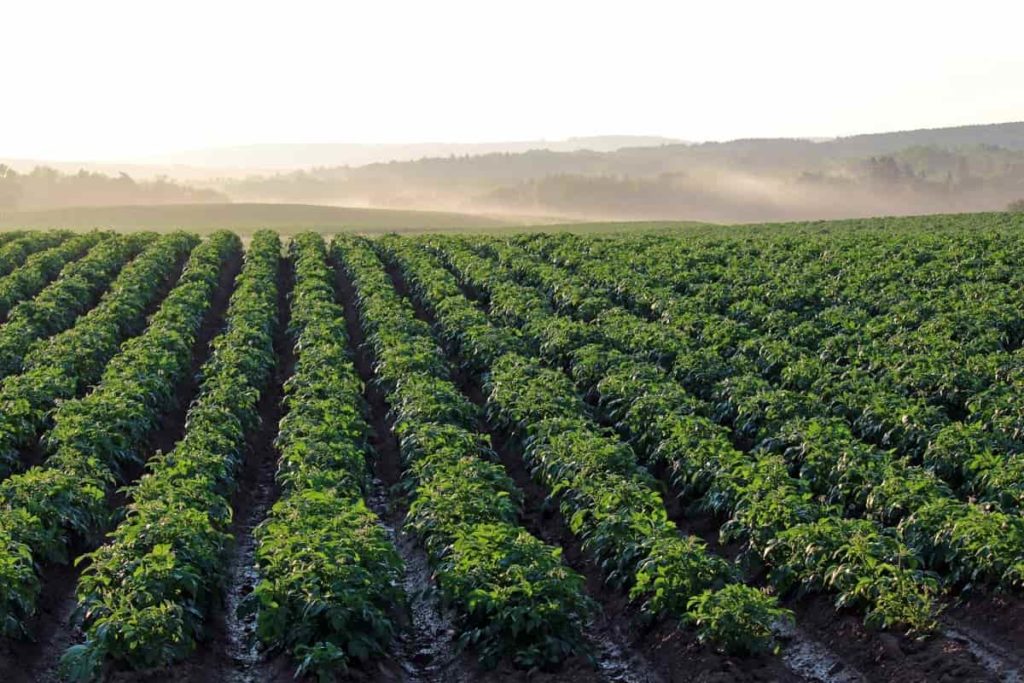
Weed control in Potato farming
It is important to control weeds in Potato fields, as they compete with the crop for water, nutrients, and light and are hosts to pests and diseases. Weed control may include systems used only in cultivation, herbal medicines, or a combination of cultivation and herbicides. An effective weed control program addresses weed problems in the field. Fields with perennial herbs should be avoided.
The choice of herbicides will include familiarity with the herbicides labeled for Potatoes, understanding the weeds in the fields, and the need to control potential weed species. Weed can be a big problem for Potatoes as they compete for light, water, and nutrients. They can also host pests and diseases. Mulches can be used to suppress weeds. For Potatoes, hand planting is the most widely used weeding strategy. If you use herbicides, they are labeled for use on Potatoes and follow the instructions on the label.
Pests, Diseases, and their control in Potato farming
Many pests can cause serious problems in Potatoes, including Colorado Potato beetles, flea beetles, aphids, leafhoppers, wireworms, and corn borers. Monitoring insect populations through scouting is important in determining when you should use pesticides and what materials you should spray. Some new pesticides are applied to the furrow at the time of planting.
Many Potato diseases can cause severe damage to the crop if not managed properly. These include Early Blight, Late Blight, Leaf Roll, Mosaic Viruses, Rhizoctonia, Verticillium Wilt, Fusarium Dry Rot, and Bacterial Soft Rot. Although the list of diseases is very well known, most diseases can be treated with disease-resistant varieties, crop rotation, and proper use and timing of fungicides.
Irrigation management for Potato farming in the USA
Soil moisture is probably the most critical factor in determining Potato production and quality. In Central Oklahoma, a Potato crop requires 20 inches or more of water. When irrigation is practiced to supplement rainfall, it should be applied repeatedly but in small amounts. Cracks in secondary growth and development occur when there is irrigation or rain after moisture pressure.
Potatoes can be grown successfully using various irrigation systems, including overhead sprinklers and drip irrigation systems. The soil is kept evenly moist until the Potato tubers reach full size. Considerations for irrigation management decisions include: The effective depth of Potato roots is 2 feet. Excess moisture in the field will adversely affect Potato production and quality. It is almost impossible to prevent the soil from drying out to less than 65% of the field capacity on very sandy soils due to the low water-holding capacity of sandy soils.
During growth, maintain soil moisture supply. Apply fertilizer to the soil, especially on sandy soils. Moisture pressure followed by irrigation or rain can cause cracks in the growth and other growths. If the rains are accompanied by hot weather, the rest of the growing tubers may break and cause the tubers to break into the ground. Too much water enlarges the holes in the tubers, and they rot easily when stored.
Potato plant care in the USA
All the tubers on the Potato plant grow from the top of the seed. Since the seed piece is planted only 3 inches deep, the soil should be pulled towards it as the plant grows. It gives space for the shoulders to form. Some growers use thick mulch for this purpose.
In case you missed it: Organic Potato Farming; Planting; Harvesting
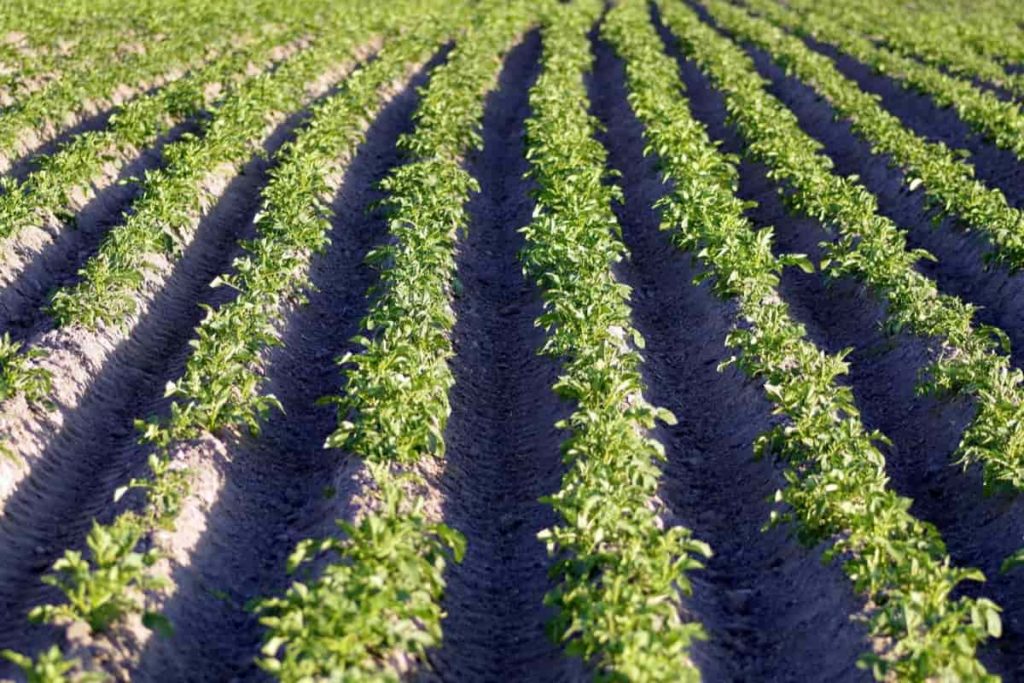
Potatoes made in soft mulch are often smooth and have a better shape than those grown in soil. This is true if the soil is heavy. As the Potatoes grow, they should be protected from sunlight, or they will turn green. When the Potato plants are 8 to 10 inches tall, apply a thick layer of mulch to block sunlight, and increase yield and quality.
The harvesting season for Potatoes in the USA
Harvesting time involves a careful examination at harvest time to ensure that the Potatoes are physically mature and suitable for maximum storage and processing of their sugar. American Potato growers invest in state-of-the-art equipment to protect Potatoes from harvesting, handling, and transportation.
Potatoes are ready to be harvested when the top begins to die, and the Potato’s skin becomes strong. When rubbed with the thumb, the skin settles when it is not easily scratched. The skin set can be sharpened by cutting the tops of the plants.
Most Potatoes are ready for harvest 80 to 115 days after planting. If Potatoes are to be stored after harvest, the plant should be allowed to mature (die) before the Potatoes are harvested. If a plant has not yet begun its maturation stage, you can kill the tops of the plant to produce maturity. Harvest the tubers about two to three weeks after the plant dies.
To harvest, carefully dig up the Potatoes and remove them from the plant’s root system. Discard the seed piece – if it is still on the plant at the end of the season – and any green tubers. You can cut small “new Potatoes” by carefully digging near the plants with your fingers during the growing season. Carefully keep the pitchfork 8 to 10 inches away from the plant to prevent the Potatoes from being cut. Pick up the plants and shake the soil.
Pull the Potatoes with the vines and handle them carefully to avoid damage. Damaged Potatoes do not store well. Let the Potatoes dry and then store them in a cool place with adequate air circulation. Most Potato varieties are ready for digging 95 to 110 days after planting. After digging the Potatoes, place the top in a compost pile.
Conclusion
In the USA, Potato is the most popular vegetable. People eat an average of 125 pounds of Potatoes annually in the USA. One in five rows is reserved for foreign consumers; American Potatoes are one of the largest agricultural exports in the United States and help feed the world. In its data, the USDA separates the Potato crop in the spring, summer, and autumn, but the Potato crop in the fall is by far the largest, which is usually the weight of the cut Potato is more than 90%. The above information is about easy ways for Potato farming in the United States.
- Economical Aquaculture: A Guide to Low-Budget Fish Farming
- 15 Common Planting Errors That Can Doom Your Fruit Trees
- How to Make Houseplants Bushy: Effective Tips and Ideas
- Innovative Strategies for Boosting Coconut Pollination and Yield
- Pollination Strategies for Maximum Pumpkin Yield
- The Complete Guide to Chicken Fattening: Strategies for Maximum Growth
- Natural Solutions for Tulip Problems: 100% Effective Remedies for Leaf and Bulb-Related Issues
- Revolutionizing Citrus Preservation: Towards a Healthier, Greener Future
- Natural Solutions for Peony Leaf and Flower Problems: 100% Effective Remedies
- Maximizing Profits with Avocado Contract Farming in India: A Comprehensive Guide
- Natural Solutions for Hydrangea Problems: 100% Effective Remedies for Leaf and Flowers
- The Ultimate Guide to Choosing the Perfect Foliage Friend: Bringing Life Indoors
- From Sunlight to Sustainability: 15 Ways to Use Solar Technology in Agriculture
- The Ultimate Guide to Dong Tao Chicken: Exploring from History to Raising
- The Eco-Friendly Makeover: How to Convert Your Unused Swimming Pool into a Fish Pond
- Mastering the Art of Delaware Chicken Farming: Essentials for Healthy Backyard Flocks
- 20 Best Homemade Fertilizers for Money Plant: DIY Recipes and Application Methods
- How to Craft a Comprehensive Free-Range Chicken Farming Business Plan
- Brighten Your Flock: Raising Easter Egger Chickens for Beauty and Bounty
- How to Optimize Your Poultry Egg Farm Business Plan with These Strategies
- Subsidy for Spirulina Cultivation: How Indian Government Schemes Encouraging Spirulina Farmers
- Ultimate Guide to Raising Dominique Chickens: Breeding, Feeding, Egg-Production, and Care
- Mastering the Art of Raising Jersey Giant Chickens: Care, Feeding, and More
- Ultimate Guide to Raising Legbar Chickens: Breeding, Farming Practices, Diet, Egg-Production
- How to Raise Welsummer Chickens: A Comprehensive Guide for Beginners
- How to Protect Indoor Plants in Winter: A Comprehensive Guide
- Ultimate Guide to Grow Bag Gardening: Tips, Tricks, and Planting Ideas for Urban Gardeners
- Guide to Lotus Cultivation: How to Propagate, Plant, Grow, Care, Cost, and Profit
- Agriculture Drone Subsidy Scheme: Government Kisan Subsidy, License, and How to Apply Online
- Ultimate Guide to Raising Araucana Chickens: Breed Profile, Farming Economics, Diet, and Care
- Bringing Hydroponics to Classroom: Importance, Benefits of Learning for School Students
- Ultimate Guide to Raising Polish Chickens: Breed Profile, Farming Economics, Diet, and Care
- Ultimate Guide to Raising Australorp Chickens: Profile, Farming Economics, Egg Production, Diet, and Care
- Silkie Chicken Farming: Raising Practices, Varieties, Egg Production, Diet, and Care
- Sussex Chicken Farming: Raising Practices, Varieties, Egg Production, Diet and Care
- Homemade Feed Formulations for Livestock: Discover Cost-effective Starter to Finisher Feed Recipes